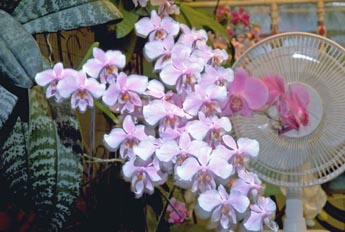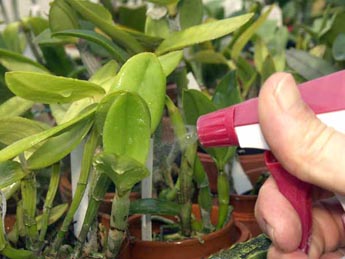|
Welcome to the AOS Beginner's Newsletter. We will be sending you monthly tips on how to grow orchids and help you get them to bloom again. In addition to the information presented here, we invite you to visit the AOS website at www.aos.org and check out the information found under ORCHID INFORMATION > ORCHID BASICS.
Give Me Some Air!
 During the 19th century "Orchidmania" craze that swept Europe, thousands of orchids would die in dry, heated "stoves", as the orchid greenhouses were called. It is surprising that any survived and it was only the sheer numbers being ripped from the jungles that allowed a hobby to be born. These early orchid hobbyists had little first-hand knowledge of where or how orchids actually grew and the plants often arrived in Europe unaccompanied by the person who actually collected them. The notion was that epiphytic orchids grew in dank, steamy, tropical jungles. There certainly are orchids that come from sea level forests close to the equator, but even in those places there is open air movement and that is the next cultural element we will cover.
During the 19th century "Orchidmania" craze that swept Europe, thousands of orchids would die in dry, heated "stoves", as the orchid greenhouses were called. It is surprising that any survived and it was only the sheer numbers being ripped from the jungles that allowed a hobby to be born. These early orchid hobbyists had little first-hand knowledge of where or how orchids actually grew and the plants often arrived in Europe unaccompanied by the person who actually collected them. The notion was that epiphytic orchids grew in dank, steamy, tropical jungles. There certainly are orchids that come from sea level forests close to the equator, but even in those places there is open air movement and that is the next cultural element we will cover.
For this newsletter we will look at humidity and air movement, both qualities of the air that surround your orchids, and you! Although there are genera-specific requirements for more or less humidity, most tropical epiphytic orchids require between 50-70% humidity. Less than 40% humidity can cause plants to grow poorly or at best, less than optimum. Plants transpire moisture through stomata, tiny pores on the leaves. If the humidity of the growing environment is too low, orchid plants will transpire water faster than they can take it up through the roots and become desiccated. Roots and potting media will also dry out quicker keeping a plant in a dehydrated state. Watering more frequently is not a solution for dehydration and leads to root problems because of rapid media decay.
 If you grow orchids in a greenhouse it is most likely properly equipped to provide an acceptable range of humidity. Evaporative coolers are an excellent means of adding humidity and keeping temperatures cooler in summer. If you grow orchids in the home, you have more of a challenge to maintain proper humidity. Winter heating and summer air conditioning both dry the air significantly. For just a few plants there is a classic solution that may be somewhat limited in its effectiveness, but is easy and provides some humidity. Fill a shallow tray, such as an aluminum oven liner, with pebbles, then add water to just below the tops of the pebbles. Set your orchid pots on the pebbles. Refill the tray every few days as needed (if algae builds up, empty the pebbles into a colander in the sink and rinse with diluted bleach, then plenty of clean water). This works well if you are growing just a few orchids on a windowsill. Misting can also help, but the water evaporates so quickly the benefits do not last long. If you have a larger collection that you perhaps grow on a plant stand or cart, an inexpensive humidifier can be bought for slightly more than the cost of a couple of orchid plants. Look for one with a large reservoir that does not need frequent refilling. Specific orchid growing setups such as orchidariums, terrariums, Wardian Cases and many under-lights setups in basements all will provide ample humidity.
If you grow orchids in a greenhouse it is most likely properly equipped to provide an acceptable range of humidity. Evaporative coolers are an excellent means of adding humidity and keeping temperatures cooler in summer. If you grow orchids in the home, you have more of a challenge to maintain proper humidity. Winter heating and summer air conditioning both dry the air significantly. For just a few plants there is a classic solution that may be somewhat limited in its effectiveness, but is easy and provides some humidity. Fill a shallow tray, such as an aluminum oven liner, with pebbles, then add water to just below the tops of the pebbles. Set your orchid pots on the pebbles. Refill the tray every few days as needed (if algae builds up, empty the pebbles into a colander in the sink and rinse with diluted bleach, then plenty of clean water). This works well if you are growing just a few orchids on a windowsill. Misting can also help, but the water evaporates so quickly the benefits do not last long. If you have a larger collection that you perhaps grow on a plant stand or cart, an inexpensive humidifier can be bought for slightly more than the cost of a couple of orchid plants. Look for one with a large reservoir that does not need frequent refilling. Specific orchid growing setups such as orchidariums, terrariums, Wardian Cases and many under-lights setups in basements all will provide ample humidity.

If you were to visit the habitat of an epiphytic orchid, let's say Cattleya mossiae shown above, you would discover a setting totally contrary to the Victorian perception mentioned in the first paragraph. You would be in the Venezuelan mountains at about 3000-4500 feet above sea level and the cattleyas would be growing in the canopy of the trees above you. Air constantly flows up the mountains and the tops of the trees sway in the breeze. Many of our favorite orchids come from this kind of airy environment. Optimum conditions for cultivating orchids are often described with the words, "buoyant atmosphere". What that describes is air that feels light and is constantly moving. Primarily, a buoyant atmosphere provides a constantly fresh supply of carbon dioxide to the trees and the orchids in them. Green plants convert carbon dioxide and water into food compounds, such as glucose, and oxygen through the process called photosynthesis. Air that is constantly moving provides other benefits, such as eliminating pockets of extreme temperatures and moderating the temperature of both air and leaves. An adequately ventilated orchid growing space discourages fungal infections by hastening the evaporation of standing water. The surest way to discourage the flower damaging fungus, Botrytis cinerea, is to increase air movement.
 Providing orchids with air movement is one of the simplest things to achieve. If you are growing a few orchids on a windowsill, merely open the window a few inches any time the outside temperature is above 50º F. If you have a grow cart of orchids, one or two six or eight inch muffin fans will do the trick. Turn them on low and aim them above or to the side of the orchids to draw air over the plants. Ceiling fans provide excellent air circulation for patios and sun rooms, while most commercial greenhouses offer fan options. If yours doesn't, buy one or two 24 inch box fans depending on the size of your structure.
Providing orchids with air movement is one of the simplest things to achieve. If you are growing a few orchids on a windowsill, merely open the window a few inches any time the outside temperature is above 50º F. If you have a grow cart of orchids, one or two six or eight inch muffin fans will do the trick. Turn them on low and aim them above or to the side of the orchids to draw air over the plants. Ceiling fans provide excellent air circulation for patios and sun rooms, while most commercial greenhouses offer fan options. If yours doesn't, buy one or two 24 inch box fans depending on the size of your structure.
As you have probably gathered; if the setting feels comfortable to you, your orchids will like it too!
Greg Allikas
May 2010
|

